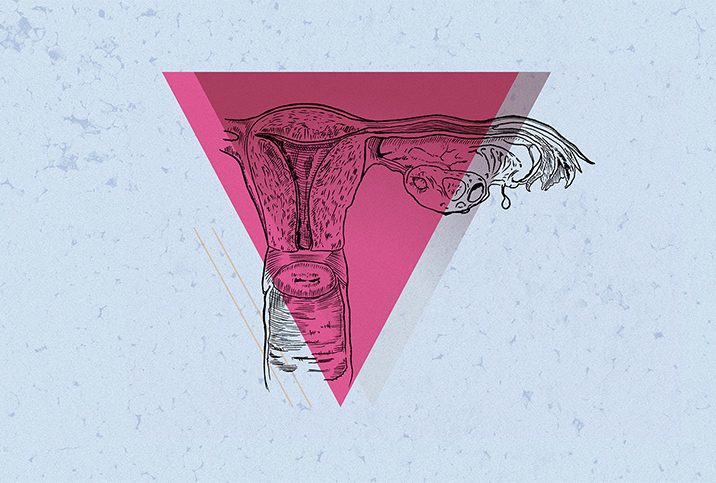Symptoms and Diagnosis of Ovarian Cancer

Ovarian cancer affects 1.2 percent of women at some point in their lives. It's the seventh most common cancer in women worldwide, but the fifth most common cancer-related cause of death. While not as common as breast cancer, ovarian cancer is considered more deadly due to its significantly higher fatality rate. Patients face an average 49.1 percent five-year relative survival rate. Ovarian cancer has such a high fatality rate due largely to a lack of good screening tests (such as mammograms for breast cancer)—patients are often diagnosed in advanced stages, reducing survival odds. Knowing early signs and symptoms to look for can lead to earlier diagnosis and increased likelihood of beating the disease.
Overview of ovarian cancer
Ovarian cancer originates in a woman's ovaries, the almond-shaped organs flanking the uterus, which produce and release female eggs, or ova, and produce estrogen and progesterone hormones. Forms of ovarian cancer include invasive epithelial ovarian cancer, ovarian stromal tumors and germ cell tumors of the ovary. Multiple risk factors for the disease include being older, taller or overweight; having family or personal history of ovarian, breast or nonpolyposis colorectal cancer, endometriosis, Lynch Syndrome, Peutz-Jeghers Syndrome or MUTYH-associated polyposis; having certain gene mutations (BRCA1, BRCA2, ATM, BRIP1, PALB2, RAD51C); beginning menstruation prior to age 12 or beginning menopause after age 55; taking hormone replacement therapy (HRT); not having a full-term pregnancy before age 35; and smoking.
Additionally, fertility treatments such as in vitro fertilization (IVF) may increase the risk of less aggressive ovarian cancers. Treatment options, which vary depending on cancer stage and location and patient characteristics and preferences, often include surgery and chemotherapy. Radiation, hormone and targeted therapies may also be an option. Ovarian cancer confined to the ovary is easier to treat. Cancer that has spread beyond the ovaries, throughout the pelvis or abdomen, or even to the lungs, brain or skin, is more difficult to treat.
Symptoms of ovarian cancer
Early signs and symptoms of ovarian cancer can be unnoticeable and undetectable by patients and clinicians alike. Only 15 percent of cases are diagnosed in early stages. There are nondescript symptoms that can be a tip-off if a woman is in touch with her body, although almost all of them can be indicative of myriad, less serious conditions. The wide list includes bloating, abdominal swelling, difficulty eating or feeling full quickly, loss of appetite, weight loss, fatigue, pelvic, abdominal or back pain, heartburn, GI upset, constipation, indigestion, menstrual changes, abnormal vaginal discharge, pain during sex, needing to urinate more frequently or feeling the sudden urge to urinate. A doctor may notice other signs, such as abdominal fluid or a lump in the abdomen.
New symptoms that linger for two weeks or more and are not relieved by appropriate alterations to lifestyle (exercise, rest, dietary changes) should be evaluated. As the cancer begins affecting the stomach or bladder, symptoms typically become more noticeable, with pain and changes in eating and bowel or bladder function. Unlike with breast cancer and other cancers, ovarian tumors typically aren't felt by the patient because the ovaries are situated deep within the abdominal cavity. Recognizing more mild symptoms and seeking care right away can result in an earlier diagnosis and better outcomes.
Methods of diagnosis for ovarian cancer
Diagnosing ovarian cancer typically begins with a pelvic exam: the external genitalia, vagina and cervix. The doctor may press on the abdomen with one hand and manipulate the pelvic organs to make them easier to examine. An abnormality may be discovered that prompts further evaluation, but ovarian tumors can also be small and difficult to feel via physical exam.
If an irregularity is noticed or symptoms require additional evaluation, abdominal and pelvic imaging (transvaginal ultrasound and abdominal and pelvic CT) will be ordered. Imaging provides a picture of the ovaries and other structures and can indicate where a tumor or cancerous cells may be present. Blood tests are also critical, providing an overview of a patient's general health and flagging specific markers that may indicate the presence of ovarian cancer—for example, a marker like cancer antigen 125, although this protein can also be indicative of other medical issues or changes, such as fibroids, menstruation and uterine cancer. None of these tests confirms a cancer diagnosis, but they can indicate the possibility of cancer, in which case a biopsy (the collection of small tissue samples for analysis under a microscope) would be performed. Occasionally, diagnoses aren't made until after an ovary is removed and tissue is sent to pathology for analysis.
Determining the aggression and spread of the cancer
Once a diagnosis of ovarian cancer is confirmed, a pathologist analyzes the cells under a microscope, and the information and imaging are used to help determine the stage of the cancer. Stages range from I to IV, indicating the origin of the cancer and how far it has spread. Early stages indicate the cancer is contained to the ovaries and nearby areas, and later stages indicate an increasing spread. Roughly 15 percent of women are diagnosed with stage I ovarian cancer, 19 percent with stage II, 60 percent with stage III and 6 percent with stage IV.
Stage I ovarian cancer is divided into IA, IB and IC. IA is cancer localized to an ovary, IB indicates cancer in both ovaries and 1C means cancer is on the outside of an ovary.
Stage II includes IIA for cancer that has spread to the fallopian tubes or uterus, and IIB for cancer that has spread to the bladder or rectum.
Stage III is broken down into IIIA, for a spread to the abdominal lining and lymph nodes; IIIB, a spread to the abdomen with visible masses less than 2 centimeters long; and IIIC, with masses on the abdomen, liver or spleen greater than 2 cm.
Finally, Stage IV ovarian cancer includes IVA, where the cancer is found in the fluid around the lungs, and IVB, where the cancer is inside the liver, spleen or distant organs such as the brain or skin.
Staging is one of several factors that helps determine a patient's outlook. Along with overall health, treatment methods and response to them, staging indicates the likelihood of survival, which treatments may be best, and in what order and combination. Staging also incorporates cancer grade, a numerical description of how abnormal the cancer cells look under a microscope, an indication of how quickly they are likely to grow.
Low-grade cancers are considered less aggressive; a lower cancer grade and stage generally indicate a better prognosis and higher survival rate. Ovarian cancer five-year survival rates vary depending on the individual and type of ovarian cancer. Survival rates typically decrease with increased stage and aggressiveness of cancer. Average five-year survival rates (the percent of women who are alive five years after treatment) are 85 to 94 percent for stage I ovarian cancer; 57 to 78 percent for stage II; 39 to 59 percent for stage III; and 17 percent for stage IV.
Prevention of ovarian cancer
There's no proven way to eliminate ovarian cancer risk, but a number of lifestyle changes can reduce a woman's chances of developing it. A balanced diet high in whole foods (fruit, vegetables, whole grains, legumes) and low in processed foods, red meats and added sugars may lower risk. A 2009 study from the American Journal of Clinical Nutrition looked at 40 food groups and the eating patterns of 683 women and reported a significant association between meat and fat consumption and ovarian cancer risk.
Avoid using talcum powder on your genitals, pads, diaphragms or condoms; while studies disagree on the association with ovarian cancer, some research suggests talcum powder increases cancer risk. Women who have children at a younger age (research indicates before age 26) and breastfeed (ideally for at least one year) may have a lower risk of both ovarian and breast cancer. Risk decreases further with additional full-term pregnancies.
Certain birth control methods can also help. Studies indicate oral contraception, intrauterine devices (IUDs) and even tubal ligation may decrease the odds of developing the disease. For high-risk women or those recommended for other reasons, removal of the uterus (hysterectomy) may lower risk by a quarter and tubal ligation by a third, according to findings from a 2012 study from the Journal of Ovarian Research.
Don't smoke—a 2013 pooled analysis of 21 case-control studies published in Cancer Causes Control found smoking increased odds of three different types of ovarian cancer by 30, 31 and 83 percent.
Ovarian cancer's deadly reputation is largely linked to the difficulty in diagnosing it. While science continues to develop more accurate screening and detection methods, knowing your risk, paying close attention to your body and seeking evaluation for even subtle symptoms will go a long way in helping to save your life.


















